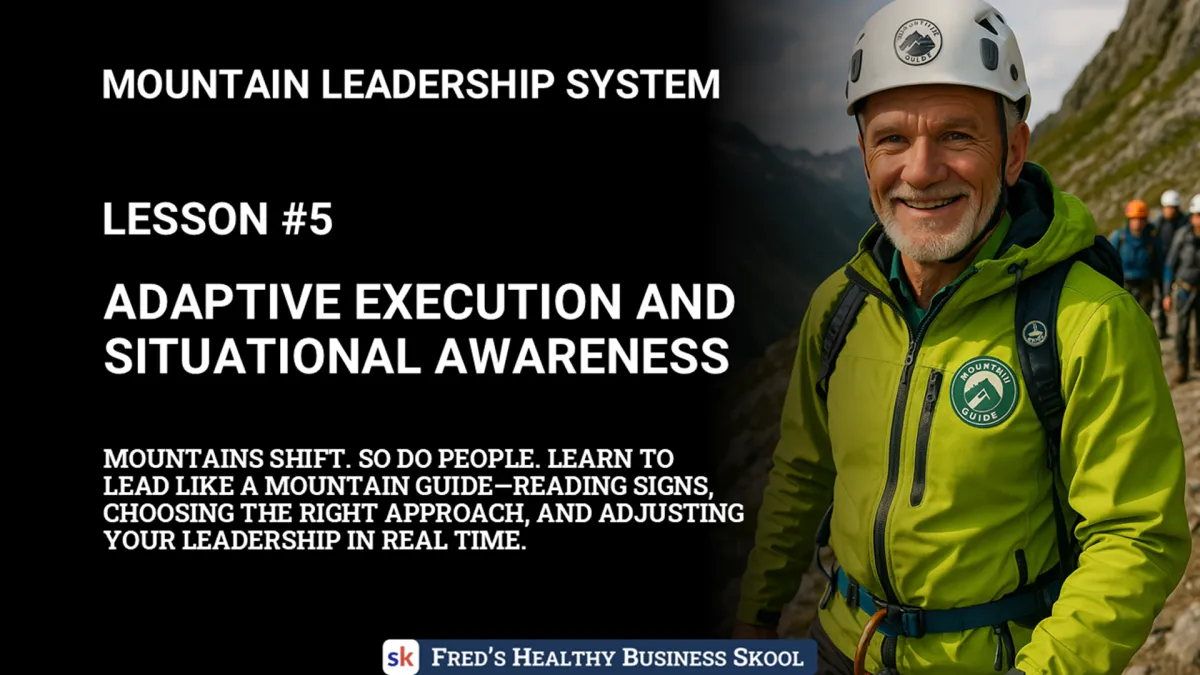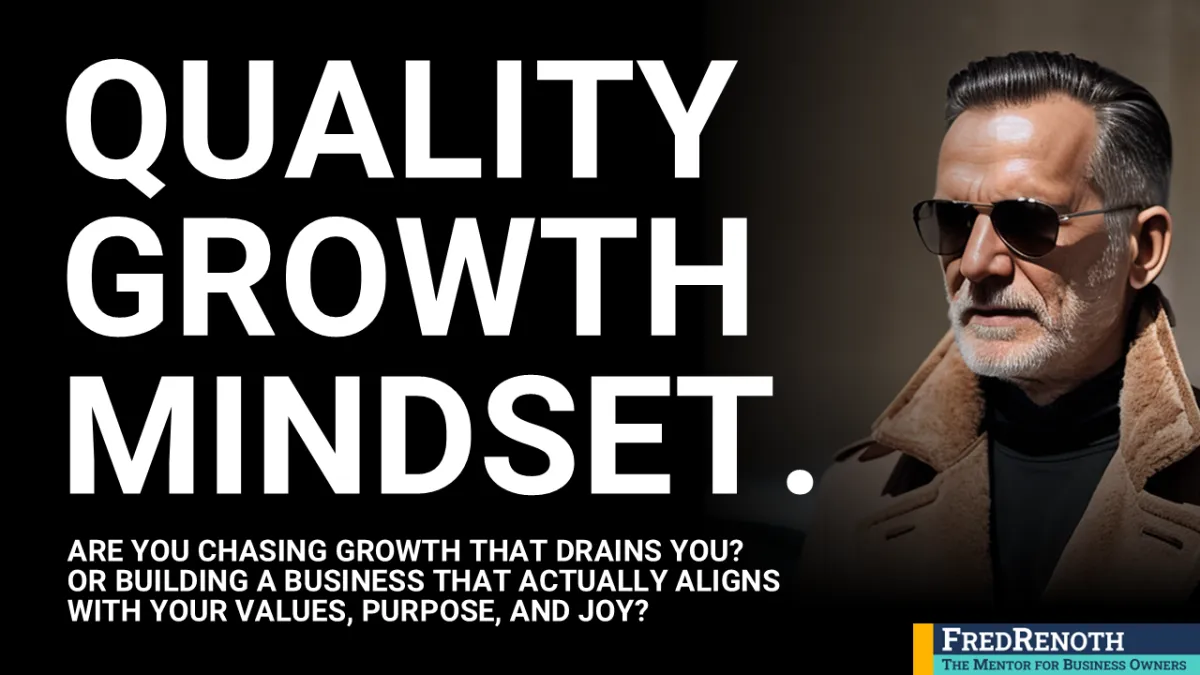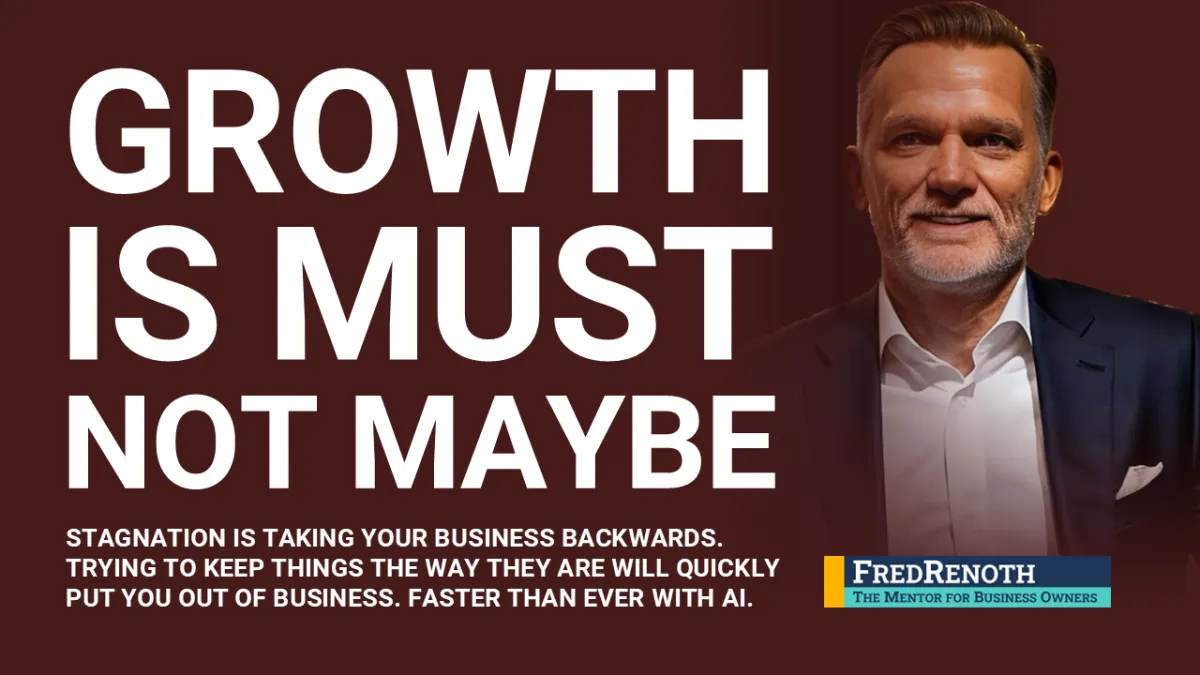


Welcome to Fred's
the Healthy Business BLOG

Lesson #5 - Leading with Situational Adjustments
Great leadership isn’t rigid it’s responsive. Adaptive Execution is the ability to lead with eyes open and ego down, sensing what your team needs and responding with clarity.
In this lesson, you’ll learn to read people the way a mountain guide reads the trail - by noticing the subtle shifts, listening beyond words, and adjusting your posture accordingly. You’ll train your leadership radar, master the four core leadership modes, and build the confidence to shift between them with intention.
Whether your team needs direction, coaching, collaboration, or space to grow - this module gives you the tools to act wisely and in rhythm with what’s really happening. This is how trust is built. This is how momentum is maintained.
Adaptive Execution is not about being perfect - it’s about being aware. And it’s a skill every transformational leader must develop. Welcome to the leadership module that teaches you how to stay grounded - even when the terrain keeps changing.
WEEK 1: READING THE TERRAIN
Leadership is not just what you say - it’s what you sense.
The air at high altitude is thinner. You breathe harder. You feel the terrain change underfoot, even before you see the ice. A mountain guide knows the signs. The way the snow crunches. The way clouds hang too low in the morning.
What looks like clear skies to an amateur may signal a storm to the experienced. Leadership is no different.
You’re not just leading a team - you’re leading through terrain that’s constantly shifting. And if you're not paying attention, you’ll walk straight into an avalanche of confusion, burnout, or resistance. That’s why Week 1 of Adaptive Execution (Situational Adjustments) starts not with action - but with awareness.
Situational awareness is the leader’s radar. It’s not instinct. It’s not guesswork. It’s a trained capacity to observe, interpret, and decide. And most importantly—it’s a skill you can sharpen.
Let’s begin with a brutal truth: many leaders miss what’s right in front of them. Not because they don’t care. But because they haven’t trained their senses. They’re too busy talking to notice who stopped listening. Too focused on the plan to see that someone’s falling behind.
This week, you’ll learn how to see again. Really see. You’ll learn to spot tension in silence. To hear what’s behind the words. To notice when someone’s dialed in—or mentally checked out. This doesn’t require psychic powers. It requires humility and attention.
That’s what great leaders do. They walk into a room and scan the landscape. Not with judgment. Not with agenda. But with presence.
They ask:
What’s going on here?
Who’s energized, and who’s drained?
Where’s the unspoken tension hiding?
What’s not being said?
Here’s the secret: your team is always giving you signals. In tone. In posture. In speed. In silence. The question is - are you tuned in?
Emotional intelligence is not just about being “nice” or “supportive.” It’s about precision. The ability to assess mood, motivation, and mindset in real-time - and to lead accordingly. In fact, according to a 2019 TalentSmart EQ study, 90% of top performers score high in emotional intelligence. It’s not fluff. It’s function.
And communication? That’s not just about giving instructions. It’s about noticing how they land. Great communicators don’t just speak clearly - they watch carefully. They notice the raise of an eyebrow, the pause before a nod, the glance to a teammate.
This week, your work is simple but not easy: observe. Take one meeting this week and say less. Watch more. Listen deeper. Track the mood. Who leans in? Who checks out? Who speaks with conviction? Who hesitates?
Leadership radar is built in moments like this. Not in the loud declarations - but in the quiet spaces between them.
Your goal is not to jump to conclusions. It’s to stay open. That’s where adaptive execution begins. With leaders who don’t force an agenda—but read the room like a guide reads the weather.
Mountains change. So do people. And great leaders learn to see it - before it hits them in the face.
End of Week 1 Review: Self-Check-In
Reflect on your experience this week:
What surprised you about what you observed in your team?
Did you catch yourself jumping to conclusions or staying curious?
In which moments did you feel most “tuned in”? Least?
What new signals did you start noticing that you used to miss?
What one change will you make in how you “read the terrain” next week?
WEEK 1 Questionnaire: Start Building Your Leadership Radar
Use a scale of 1 (rarely) to 5 (always) to rate the following:
I observe team members’ body language during meetings.
I can tell when someone on my team is mentally checked out.
I listen to what’s not being said in a conversation.
I reflect on how my messages are received, not just how I deliver them.
I intentionally pause to observe dynamics before I act or speak.
I remain present in group settings without multitasking.
I can identify shifts in mood or energy within my team.
I stay curious rather than making quick assumptions.
I create space for people to express what’s under the surface.
I trust my observations as valid leadership data.
Total Score out of 50:
41–50: Your radar is sharp. Stay grounded and continue honing.
31–40: You’re tuned in, but there’s more to explore.
21–30: Start making space for silence and observation.
Below 20: Time to take off the leadership blindfold. Your team needs you to see them.
WEEK 2: THE FOUR MODES OF LEADERSHIP
“Flex your approach, not your values.”
If Week 1 sharpened your radar, Week 2 puts tools in your hands. You now see the terrain more clearly - so what do you do with that insight? You act. But not the same way every time.
Leadership isn’t about having one style. It’s about having a toolkit. Think of it like hiking gear: you don’t wear snow spikes on dry gravel. You don’t climb ice with bare hands. You match the moment with the method.
In the Mountain Leadership System, we teach four distinct leadership modes. Not personality traits. Not fixed styles. But situational responses—deliberate choices based on what your team needs right now. The goal isn’t to switch styles like costumes, but to embody the right energy, posture, and role for the trail you’re on.
Let’s walk through the four modes.
Direct Mode – Lead the Line Sometimes the fog rolls in.
Fast. There’s confusion. There’s urgency. A decision must be made. And the last thing your team needs is a brainstorming session.
This is when you lead with clarity. You set the direction. You make the call. You say, “Here’s what we’re doing, and here’s why.” It’s not micromanagement. It’s decisive guidance. And when used well, it creates relief.
Many leaders are afraid of this mode because they confuse clarity with control. But clarity is a kindness. In fact, research by Gallup shows that clarity of expectations is one of the strongest predictors of team engagement and performance.
When there’s doubt, be the voice of focus.
Coach Mode – Fuel the Climb Sometimes the terrain is open, and the team is growing.
People are capable—but not yet confident. They don’t need to be told what to do. They need to be asked powerful questions. That’s when you coach.
You say: “What do you think would work best here?”
Or: “What did you learn from that result?”
You guide with feedback, not commands.
This is where transformation happens. According to a 2021 report by BetterUp Labs, coaching leadership styles can improve employee resilience by 43% and increase performance outcomes by 25%. Not because the leader has all the answers - but because the leader helps others find theirs.
Collaborate Mode – Share the Rope There are moments when trust is high.
The team is strong. The challenge is complex, and no single mind can solve it. This is the time to step into shared power. You shift from “I lead” to “We lead.”
You open the conversation. You let ideas surface. You align. You negotiate. You co-create the next move. This mode requires emotional maturity and the ability to stay present without grabbing the reins. It’s not abdication - it’s activation.
Collaborative leadership, according to Harvard Business Review, increases innovation and problem-solving capacity across teams by as much as 34%. It’s slower - but smarter. You move together, and that’s what makes you faster in the long run.
Step Back Mode – Let Others Lead This is the rarest, and often the most powerful.
It’s when you trust someone enough to get out of their way. To let them rise. To let them make the call, even if it’s not perfect. This is where real leadership is born - when the leader stops leading.
You stay present, but you don’t interfere. You watch them grow into the role. You give space, not abandonment. You don’t disappear - you observe supportively from the edge of the trail.
In a study published in the Journal of Applied Psychology, researchers found that leaders who empower others by stepping back increase team initiative, ownership, and overall productivity. Not because they do less but because they do what matters most: create ownership.
Now here’s the danger: most leaders have a favorite mode. Some love to direct. Others live in collaboration. Some get stuck coaching. The risk is not in using one of these—it’s in only using one of them. That’s when things break.
In Week 2, your practice is to notice which mode you default to - and which ones you avoid.
You’ll also begin to pair what you learned last week (how to read the terrain) with how to choose your response. Your radar tells you what’s happening. These four modes tell you what to do about it.
Leadership becomes jazz - not a rigid score. You’re adapting, not reacting. Responding, not controlling. This is adaptive execution in motion.
End of Week 2 Review: Leadership Mode Reflection
Reflect on your experience this week:
Which leadership mode do you naturally prefer? Why?
When did you last shift your leadership mode—and how did it feel?
Which mode are you least comfortable with? What makes it hard to use?
What happened when you tried a new mode in a conversation or meeting?
How does it feel to lead with intention, not instinct?
WEEK 2 Questionnaire: Leadership Mode Awareness
Rate yourself from 1 (not at all) to 5 (very often):
I confidently give clear, direct guidance when needed.
I ask thoughtful questions that help others reflect and learn.
I invite collaboration and value input from my team.
I can step back and let others lead without interference.
I reflect on which leadership mode I’m using and why.
I adapt my style based on the person and context.
I notice when my preferred leadership mode is not working.
I can shift modes without losing my sense of self.
I recognize the strengths of each leadership mode.
I create space for others to develop their own leadership.
Total Score out of 50:
41–50: You’re a versatile, intentional leader—keep tuning your craft.
31–40: You’re aware and adaptable—expand your range.
21–30: Good start, but time to flex new muscles.
Below 20: You may be stuck in one style—open up and shift your stance.
WEEK 3: KNOWING WHEN TO SHIFT
“It’s not just how you lead—it’s when you lead that way.”
There’s a reason even seasoned hikers check the sky every hour. The trail can look the same—but the wind’s changed. The sun’s dropped. That stream you crossed earlier? Now a flood. The rock that looked steady? Now it’s wet and slick.
And the same goes for your team. One of the hardest parts of leadership isn’t choosing what to do—it’s knowing when to change course.
Week 3 is about timing. You’ve trained your radar. You’ve learned the four modes. But now comes the part where most leaders get stuck: recognizing when to shift and actually doing it before it’s too late.
Here’s the truth: your best leadership posture becomes a liability when it’s overused. Direct mode turns into dictatorship. Coaching becomes avoidance. Collaboration starts to look like indecision. Stepping back becomes abandonment.
And often, we don’t even notice. Because comfort is silent. Ego whispers, “This is your strength—just lean into it more.” But leadership isn’t about playing to your strength. It’s about staying aligned with the moment.
Think about it:
Have you ever kept coaching someone who just wanted clarity?
Ever collaborated when your team really needed a decision?
Ever stepped back when someone was secretly sinking?
These aren’t just missteps. They erode trust. When a leader misses the moment to shift, the team starts to question your awareness. Or worse—your commitment.
Leadership agility means you’re always checking the conditions. And that means asking:
What’s changed since last week?
What signals am I getting now?
What does this person need today?
It’s subtle, but vital. That’s why this week, you’ll study the art of noticing.
You’ll learn to sense when energy drops, or frustration rises. You’ll recognize the moment when your feedback is no longer landing. You’ll feel when collaboration is turning into chaos. And you’ll act.
Here’s a skill worth mastering: recovery. Even the best leaders misread the terrain. You’ll choose the wrong mode sometimes. What matters is what you do next. Own it. Adjust. Debrief. Clarity builds credibility.
Imagine this: “Hey team - yesterday I stepped in and gave a lot of direction. I realize now that some of you had ideas that didn’t get airtime. I want to rewind and open the floor. Let’s revisit this together.”
You didn’t lose authority. You gained trust. Leaders who can admit they missed a signal and recover with grace are the ones others want to follow.
Now a word of caution: don’t confuse shifting modes with people-pleasing. You’re not reacting to mood swings. You’re reading the map. You’re leading from awareness—not emotion.
This week, you’ll also learn to distinguish urgency from anxiety. Urgency requires action. Anxiety just wants relief. Good leaders know the difference. They don’t shift modes because they feel pressure. They shift because the situation calls for it.
Timing is everything. And when you master this, leadership becomes less about force—and more about flow.
End of Week 3 Review: Agility in Action
Reflect on your experience this week:
When did you notice a leadership mode that wasn’t working anymore?
How did it feel to shift into a different posture?
What signs helped you make the decision to shift?
When did you miss the moment—and how did you recover?
What new habit are you building around checking the “weather” in your team?
WEEK 3 Questionnaire: Agility and Awareness
Rate yourself from 1 (not yet) to 5 (consistently):
I reflect regularly on whether my current leadership mode is still effective.
I can identify when a situation requires a different approach.
I respond to changes in team energy or dynamics with a shift in leadership.
I debrief with my team after a leadership misstep.
I can distinguish between urgency and emotional pressure.
I stay grounded when others are anxious.
I act intentionally, not just reactively.
I feel confident adjusting my leadership in the moment.
I give my team context when I shift approaches.
I recognize when it’s time to step in—or step out.
Total Score out of 50:
41–50: You’ve got real-time agility—lead with trust and intention.
31–40: Solid foundation—keep refining your timing.
21–30: Practice shifting sooner and debriefing openly.
Below 20: You may be stuck on autopilot—begin noticing the terrain again.
WEEK 4: PUTTING ADAPTIVE EXECUTION INTO PRACTICE
“Adaptability is not weakness - it’s wisdom in motion.”
You’ve reached the summit - but the real journey starts now. Week 1 opened your eyes. You began to read the emotional terrain. Week 2 handed you the four modes of leadership—Direct, Coach, Collaborate, Step Back. Week 3 taught you when to shift. You started listening deeper, adjusting faster, and recovering smarter.
But theory means nothing if it’s not lived. This final week is about turning practice into rhythm. About walking out the door each morning with a personal map—ready, not rigid. Grounded, not controlling.
Let’s be clear: adaptive leadership isn’t a checklist. It’s not a script. It’s a way of being. The goal isn’t to be perfect. The goal is to become attuned—like a guide who can smell a change in the air. Your team is counting on you. Not to be a superhero. But to be present, real, and responsive.
So here’s what we do this week. You’ll create your Adaptive Execution Map.
This isn’t some glossy chart to hang on your wall. It’s a live, breathing set of cues that helps you lead with clarity. You’ll design it based on what you’ve observed in your own leadership patterns—the terrain you tend to overlook, the modes you avoid, the moments you delay a shift.
Start by answering this:
What are the signs that tell me I’m in the wrong leadership mode?
For some, it’s when your meetings drag and nothing moves forward. That’s a sign to Direct.
For others, it’s when your team feels stuck but no one’s growing. That’s a call to Coach.
Or maybe people are checking out because they feel shut down. Time to Collaborate.
Or maybe your presence is crowding someone else’s growth. Time to Step Back.
Write these down. Build your cue system. Your inner radar.
Then, simulate. Walk through three recent scenarios—real ones. Ask:
What mode did I choose?
What mode was actually needed?
How did it impact the outcome?
Now go one step deeper. Reflect on a tense moment you mishandled. Own it. Ask yourself not just “What should I have done differently?”—but “What signal did I miss?” That’s where your future wisdom is hiding.
You’ll also role-play with yourself this week. Run micro-scenarios in your head or with a peer. Practice shifting modes on cue. Practice naming the shift. Practice explaining your choice. The more fluent you become, the more naturally you’ll adjust in real-time.
And now, a warning. Do not make Adaptive Execution another pressure point. You are not a robot. You will not always get it right. And that’s okay. What matters is that you notice, learn, and recover. That’s what earns respect. That’s what creates trust.
The most respected leaders are not the ones who always lead right. They’re the ones who lead with awareness.
They show up.
They sense.
They shift.
They move with the mountain - not against it.
You don’t need to have all the answers. But you do need to be present. Because adaptive leadership isn’t about reacting to chaos - it’s about creating clarity inside it.
Your team doesn’t need perfection. They need to know you’re watching. That you’re learning. That you care enough to lead differently when the moment demands it.
That’s the heart of Adaptive Execution. Now - make it yours.
End of Week 4 Review: Execution Reflection
Reflect on your experience this week:
What patterns did you identify in your leadership shifts?
Which cues were hardest to recognize? Why?
What did your simulations reveal about your instincts?
How will you use your Adaptive Execution Map moving forward?
What final insight do you want to carry with you into the next phase of leadership?
WEEK 4 Questionnaire: Integration and Practice
Rate yourself from 1 (not yet) to 5 (yes, consistently):
I reflect on recent leadership moments to extract learning.
I’ve created a system for recognizing when I need to shift modes.
I can explain my leadership choices to others clearly.
I simulate or review situations to improve my agility.
I lead without rigidity, but with grounded intention.
I adjust leadership style while staying true to my values.
I recover from leadership missteps with honesty and clarity.
I practice adaptive leadership as a daily habit.
I sense team dynamics and adjust quickly in real time.
I feel confident using Adaptive Execution in complex situations.
Total Score out of 50:
41–50: You’re leading with awareness and rhythm—keep practicing mastery.
31–40: Strong integration—refine the final pieces.
21–30: Build more structure around your reflection and simulations.
Below 20: You’re still operating from instinct—let’s shift into intention.
5-Step Action Plan: Put Your Values in Motion
1. Name Your Five: Write down your core values. Not what sounds good—what feels true. Use the MLS values (Honesty, Kindness, Commitment, Accountability, Consistency) as anchors or choose your own. Post them where you can see them every day.
2. Audit Your Actions: Look at your week. In what moments did you live those values? Where did you drift? Reflect honestly—not to judge yourself, but to recalibrate. Small misalignments become big trust leaks if left unchecked.
3. Speak Them Out Loud: Start naming values in your team language. Say things like, “I’m giving this feedback because honesty matters to me,” or “Let’s follow through—consistency builds trust.” When you speak your values, others feel permission to do the same.
4. Lead by Example When It’s Hardest: Pick one value and one high-pressure moment this week. Practice living it when it’s inconvenient. That’s when values become real. Anyone can be kind when things go well. Be kind when you’re under fire.
5. Create a Weekly Rhythm: Every Friday, ask yourself and your team: “Where did we lead with our values this week?” Make it a habit, not a slogan. Consistency isn’t glamorous—but it’s what separates leaders who inspire from those who just manage.
Final Thought: Leadership That Beats Like a Heart
Values don’t live on mission statements. They live in decisions. They show up in how you handle tension, how you treat people under pressure, and what you do when no one’s watching.
Most people don’t follow perfect leaders - they follow ones who are predictably principled. Whose actions line up with their intentions. Who make mistakes, own them, and return to center - not because it’s easy, but because it matters. The heartbeat of your leadership isn’t in your role. It’s in your rhythm.
When your team knows what you stand for - because they see it in what you stand up for - they trust you. And when they trust you, they follow you, even into tough terrain.
The Mountain Leadership System doesn’t ask you to perform. It asks you to become.
Lead with your values - not just when it’s safe, but when it’s real. That’s where your leadership becomes unforgettable.
Share your insights and benefit from the HBS community!
Don’t go it alone. Join the conversation in the HBS Community at Fred's Healthy Business School. Share your insights, questions, and real-life lessons. We grow stronger when we grow together.
Want to Take it a Step Further?
Enjoyed this article?
It may give you a taste of what we talk about with our clients in the FredRenoth Mentoring Program.
Check out our website (CLICK HERE FOR WEBSITE).
And, of course, I'm ready to answer all your questions in a VALUE CALL. Just click the link.
Copyright 2025 Sysbizz LLC - All Rights Reserved
















